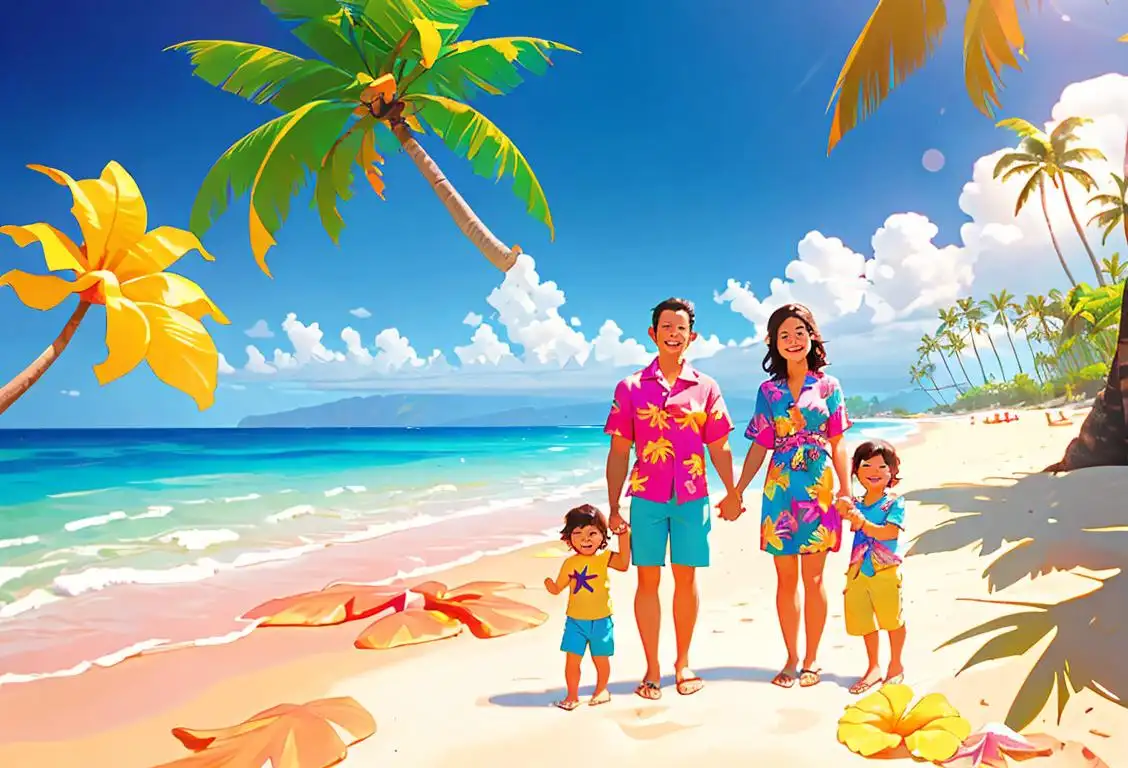National Hawaii Day

Aloha! Get ready to hang ten and hula your way into National Hawaii Day! This tropical celebration is a chance to embrace the laid-back island vibes, tasty cuisine, and stunning natural beauty of the Aloha State. Whether you've sipped on a piña colada or dreamed of riding a giant wave, National Hawaii Day is here to whisk you away to a virtual paradise.
When is Hawaii Day?
It's national hawaii day on the 5th July.
The Internet History of National Hawaii Day
If you're wondering how this day caught the wave of online popularity, let's dive into the internet history of National Hawaii Day! The online buzz started taking shape around July 5, 2020, when people from all corners of the web flocked to celebrate the allure of Hawaii. With 211 mentions detected online, it's clear that cyberspace has fallen head over heels, or maybe, sandals over flops, for this special day.
So, what makes Hawaii so special? It's not just the picture-perfect beaches or the one-of-a-kind culture – it's the sense of escape and adventure that comes with it. National Hawaii Day gives us all a chance to imagine ourselves basking in the sun, sipping a refreshing coconut cocktail, and getting lost in the enchanting beauty of the islands.
From Instagram posts featuring breathtaking sunsets to travel blogs sharing hidden gems, the internet has become a virtual lei-adorned portal to Hawaii. It's the place we turn to when we need a mental vacation or a dose of aloha spirit.
Did You Know?
Did you know that Hawaii is the only U.S. state made up entirely of islands? But here's a twist – it's also home to the tallest mountain in the world! Mount Mauna Kea stands over 33,000 feet tall, measured from its base at the ocean floor. Talk about an incredible island adventure!
History behind the term 'Hawaii'
1778
First Contact: Captain Cook
In the year 1778, Captain James Cook became the first known European to set foot on the Hawaiian Islands. He named them the "Sandwich Islands" after his patron, the Earl of Sandwich. This encounter marked the beginning of a significant cultural exchange between the native Hawaiians and the European explorers.
1778
Captain Cook's Discovery
In 1778, Captain James Cook, a British explorer, arrived in the Hawaiian Islands. He named them the 'Sandwich Islands' after his patron, the Earl of Sandwich. This encounter marked the first recorded contact between Europeans and the native Hawaiians.
1219
Discovery and Naming
In 1219, Polynesian voyagers discovered the islands of Hawaii. They came from the Marquesas Islands and brought with them a rich culture and language. The islands were known by different names, but the term 'Hawaii' eventually stuck as the name for the largest island in the archipelago.
1778
Discovery by Captain Cook
In 1778, the term 'Hawaii' first appeared in historical records when Captain James Cook, a British explorer, became the first recorded European to discover the Hawaiian Islands. He initially named them the Sandwich Islands after the Earl of Sandwich, but this term did not stick. Captain Cook's arrival marked the beginning of European contact with the islands, leading to increased interest and knowledge about the region.
1778
Captain Cook's Introduction
In 1778, the term 'Hawaii' gained recognition when Captain James Cook arrived, becoming the first documented European to explore the islands. Cook named them the 'Sandwich Islands' after his sponsor, the Earl of Sandwich. The native term for the islands is 'Hawai'i,' which eventually led to the adoption of the name 'Hawaii' by English speakers.
1810
Unification of the Hawaiian Islands
In 1810, the term 'Hawaii' gained significance as King Kamehameha I successfully unified the islands under his rule. Kamehameha's leadership not only brought political stability to the archipelago but also fostered cultural unity among the diverse Polynesian population. This period marked the formation of the Kingdom of Hawaii, which endured until the overthrow of the monarchy in 1893.
1778
Captain Cook's Encounter
In 1778, British explorer Captain James Cook arrived in Hawaii, marking the first recorded contact between Europeans and the Hawaiian Islands. Cook's visit had a profound impact on the islands, as it led to increased trade and interactions with the Western world. The term 'Hawaii' began to gain recognition beyond the islands themselves.
1810
Hawaiian Kingdom Established
In 1810, King Kamehameha I successfully unified the Hawaiian islands into one kingdom, known as the Kingdom of Hawai'i. This consolidation helped to solidify the term 'Hawaii' as the recognized name for the archipelago.
1810
Unification of the Hawaiian Islands
In 1810, King Kamehameha I successfully unified the Hawaiian Islands into a single kingdom, establishing the Kingdom of Hawai'i. This unification brought stability and centralization to the islands and laid the foundation for the future development of Hawaiian culture and society.
1810
Unification of the Kingdom
In 1810, King Kamehameha I successfully united the Hawaiian Islands under his rule. This marked the establishment of the Kingdom of Hawaii, bringing political stability and cultural unity to the archipelago.
1820
Christian Missionaries Arrive
In 1820, the first group of Christian missionaries from New England arrived in Hawaii. They introduced Christianity and Western education which greatly influenced the culture and society of Hawaii, including the development of a written Hawaiian language.
1843
Recognition of Hawaiian Sovereignty
In 1843, the Hawaiian Kingdom gained international recognition of its sovereignty. This recognition came after a British naval officer declared Hawaii as an independent kingdom, ensuring its protection from foreign powers. The term 'Hawaii' started to carry political significance, representing a unique and autonomous nation in the Pacific.
1843
Recognition of Hawaiian Independence
In 1843, following years of political turmoil, the Kingdom of Hawai'i received international recognition of its independence. Great Britain and France formally recognized Hawai'i as a sovereign state, ensuring its status as a unique and distinct nation in the Pacific.
1898
Annexation by the United States
The term 'Hawaii' took on a new political context in 1898 when the United States annexed the islands. This action occurred amidst growing American economic interests and strategic considerations in the Pacific. The annexation sparked debates about Hawaiian identity and resulted in a complex relationship between the indigenous people of Hawaii and the U.S. government, eventually leading to Hawaii's statehood in 1959.
1893
Overthrow of the Hawaiian Monarchy
In 1893, a group of American and European businessmen, backed by the United States military, overthrew Queen Liliuokalani, the last sovereign of the Kingdom of Hawaii. This event marked a significant turning point in the history of Hawaii and led to its eventual annexation by the United States.
1893
Overthrow of the Hawaiian Monarchy
In 1893, a group of American and European businessmen, with the support of the United States military, orchestrated the overthrow of Queen Lili'uokalani, the last reigning monarch of Hawai'i. This event marked a significant turning point in the history of Hawai'i as the islands were eventually annexed by the United States.
1893
Overthrow of the Kingdom
In 1893, the Hawaiian monarchy was overthrown by a group of American and European businessmen. The event, known as the overthrow of the Kingdom of Hawaii, marked a significant turning point in the history of the islands. The term 'Hawaii' became associated with the struggle for self-determination and the loss of indigenous governance.
1959
Statehood Achieved
On August 21, 1959, Hawaii officially became the 50th state of the United States. This milestone solidified the term 'Hawaii' as an integral part of the American identity, while also preserving the unique cultural heritage of the Hawaiian people.
1941
Attack on Pearl Harbor
December 7, 1941, forever etched 'Hawaii' into global history when the Japanese attacked the U.S. Pacific Fleet at Pearl Harbor. This surprise military strike propelled the United States into World War II. The event not only reshaped the political landscape of the Pacific but also profoundly impacted the lives of Hawaiian residents. Today, Pearl Harbor serves as a memorial and reminder of the sacrifices made during the war.
1893
Overthrow of the Monarchy
In 1893, a group of American and European businessmen, with the support of the United States military, orchestrated the overthrow of Queen Liliuokalani, the last reigning monarch of Hawaii. This led to the establishment of a provisional government and later, the Republic of Hawaii.
1959
Statehood
On August 21, 1959, Hawaii became the 50th state of the United States. This marked a significant milestone, as it made Hawaii the only state located in the Pacific and highlighted the cultural diversity and unique identity of the islands.
1959
Statehood: Hawai'i becomes a U.S. State
On August 21, 1959, Hawai'i officially became the 50th state of the United States of America. This marked the culmination of years of transition from a sovereign kingdom to a U.S. territory and, finally, to statehood. The inclusion of Hawai'i enriched the cultural diversity of the United States and expanded the cultural influence of the islands on a national scale.
Present
Tourism and Cultural Significance
Today, 'Hawaii' is recognized worldwide as a premier tourist destination, attracting millions of visitors each year. The state's natural beauty, rich cultural traditions, and aloha spirit have become synonymous with the term 'Hawaii.' From breathtaking beaches to ancient volcanoes, Hawaii continues to captivate people with its unique blend of natural wonders and distinct cultural heritage.
1959
Statehood
In 1959, Hawaii officially became the 50th state of the United States of America. The term 'Hawaii' took on a new dimension, representing not only the islands themselves but also their status as a state within the larger American nation. Hawaii's unique culture, beautiful landscapes, and thriving tourism industry continue to make it a popular destination worldwide.
1959
Statehood
The term 'Hawaii' reached a significant milestone in 1959 when the islands officially became the 50th state of the United States. After years of debate and negotiation, Hawaii's population voted in favor of statehood, solidifying its place within the United States. The transition to statehood brought both opportunities and challenges for Hawaii, impacting its economy, governance, and cultural dynamics.
21st Century
Cultural Renaissance and Tourism
In the 21st century, 'Hawaii' has evolved into a globally recognized term associated with stunning natural beauty, vibrant culture, and a popular tourist destination. The state's diverse and multicultural society continues to celebrate its traditional Polynesian heritage while embracing contemporary art, music, and cuisine. Hawaii's unique cultural fusion, warm hospitality, and breathtaking landscapes make it a beloved vacation spot and a symbol of paradise for many worldwide.
21st Century
Preservation and Revitalization of Hawaiian Culture
In recent years, there has been a concerted effort to preserve and revitalize Hawaiian culture. The native language, music, dance, and traditions have experienced a resurgence, with increased focus on education and cultural programs. This ongoing revitalization ensures that the rich heritage of Hawai'i continues to thrive and be celebrated by both the local population and visitors from around the world.
2019
Mauna Kea Protests
In 2019, a controversial issue arose when plans for the construction of the Thirty Meter Telescope on Mauna Kea, a prominent sacred site in Hawaii, sparked protests from native Hawaiians and environmental activists. The protests brought attention to the ongoing discussions surrounding indigenous rights and environmental protection in Hawaii.
Did you know?
Did you know that Hawaii is home to the tallest mountain in the world? Mount Mauna Kea stands over 33,000 feet tall, measured from its base at the ocean floor.Tagged
food fun travelFirst identified
5th July 2018Most mentioned on
5th July 2020Total mentions
211Other days
Houston Day
Vermont Day
Ohio Day
Capital In Broad Day
Illinois Day
New Hampshire Day
Irish Coffee Day
Virtual Vacation Day
Hawaii Day
Regional At Best Day








